
Rolex Winding Crown Markings: Crown symbols & What They Mean
As an enthusiast of anything, you tend to focus on each and every single detail of whatever it is that you are interested in. Because the closer you look, the more details you will notice. And you may even find yourself discovering things that you have never noticed before.
One such small detail for a Rolex enthusiast is the winding crown on the watches. And more specifically, the crown markings are made in relief on the side of the winding crown.
What you will notice if you start looking closer at the Rolex watch crown markings is that different models can have different markings. And what is interesting about this is that the markings actually tell you something about the watch and its structure.
But despite this, there is surprisingly little information on the web about the Rolex crown markings and what they mean.
This is why we have made this complete guide on Rolex crown markings so you can use it as a reference.
Rolex crown markings: a complete reference guide
To begin with, the Rolex symbol (logo) is referred to as a coronet to avoid confusion.
Even very old Rolex watches have markings on the side of their crown. On very old Rolex crowns – pre-vintage 1960 Rolexes, you will find a Rolex coronet (crown) and below that, there is a cross (+)
If you have a Rolex watch with a cross marking on the crown, it first means that you have an old Rolex watch. But what the marking really means is ”Brevet”. This means ”made in”, and the cross symbol is actually a patent cross. This cross on the crown actually has an interesting history. First off, people have confused the cross of being the Swiss flag (swiss cross), but it is not. The Swiss government actually raised a concern with Rolex’s use of the cross symbol on the crown due to potential confusion that the government was in some way endorsing Rolex. Since then, Rolex stopped using the + marking.

So if you see modern Rolex watches with the cross symbol or Rolex watches that are earlier than the 1960s, it means that it is a wrong crown for the watch and that it most likely has been changed during the course of its lifetime.
Another interesting point about the Brevet crown is that you can also find the + symbol on vintage Panerai crowns as well. This is due to the fact that Rolex and Panerai had a cooperative relationship back in the day.
What do Rolex crown markings mean?
Now, moving forward in history, you may have noticed that different Rolex watches have different symbols on their crowns. Some have dots, others have one dot, and some have a line.

To begin with, all modern Rolex watches have the coronet on the crown. This is universal for all models, but it is the symbol beneath it that is of particular interest as this actually gives us information about the watch.
A common misconception about the crown symbols is that three dots indicate a Triplock crown, two dots a Twinlock crown, and one dot a single lock crown. This would make sense, but the fact is that it is not quite that simple. Plus, Rolex does not use single-lock crowns.

Simply put, the Rolex crown markings denote the material used for the watch. Furthermore, the symbol also denotes the type of screw-down crown the watch has.
This sounds quite easy, but when you zoom in on the different materials, there is a lot to keep track of.
As you perhaps know, Rolex uses two different types of crown systems/structures for its watches.
The crown structures that they use are:
- Twin lock
- Triplock
As you might be able to guess, when you can see three dots on a Rolex winding crown, it symbolizes the trip lock crown. And when you can see two dots on the Rolex winding crown, you know it is a twin lock crown.
However, Rolex also uses a straight line on some of its watches. When you see a straight line on the crown, it symbolizes twin lock.
But at the same time, the symbol also denotes the material used, as mentioned earlier.
To help us understand the Rolex winding crown symbols better, here is a chart of the different winding crowns and their symbols.
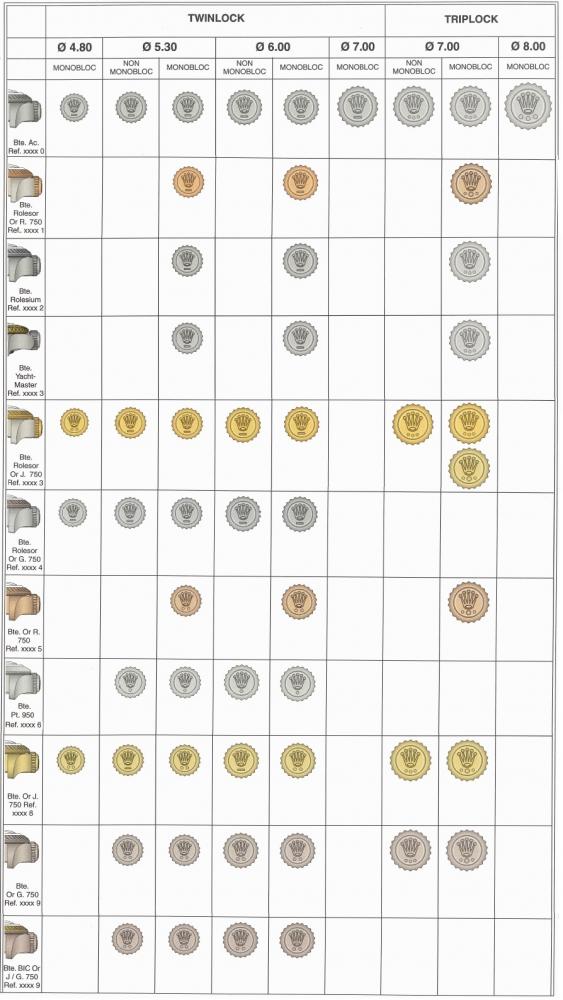
Now, this chart can be a little tricky to comprehend, but what it really says is which watches have which types of crowns.
Let’s break it down.
Each image of a watch on the chart says the last number of the reference number. The last digit of the reference number tells which material the watch is made in.
The following digits tell us the following:
0: 904L Stainless steel case
1: Rose gold two-tone (Rolesor)
2: Platinum and steel (Rolesium)
3: Steel and yellow gold (Rolesor)
4: Steel and white gold (Rolesor)
5: Rose gold
6: Platinum
8: Yellow gold
9 White gold
Now that you know what the last digit stands for, you can look at the chart and the crowns that are relevant to your exact model. For example, if I want to know which crow markings a yellow gold Rolex watch should have, I simply look at the third last line, identify which crown size I have, and then decide which marking is correct.
To make things easier for you, below are some common Rolex models listed and which crown markings they should have:
Crown markings on common Rolex models
Rolex Submariner: Triplock, marked with three dots. All modern and semi-modern Submariners have Triplock crowns, from the 16610/14060 and onwards.
Rolex Explorer II: The Explorer II has a Twinlock crown. This is marked with a straight line on the crown. This goes for both references 16570 and 216570.
Rolex Explorer I: The modern Rolex Explorer 214270 has a Twin lock crown which is marked with a straight line. This also includes the 1016, 114270 and 14270.
Rolex GMT-Master II 11671x: The GMT-Masters (pre the 12 reference) have a Triplock crown, being a robust sports watch. The new reference 12671X also has the Triplock crown. This is marked by three dots on the crown on both references.
Rolex Daytona 1165XX: The Rolex Daytona has a Triplock crown being a Rolex sports watch. Marked with three dots.
Rolex crown systems
The Rolex twin lock and two-lock crowns are structured a little bit differently.
Here is a picture of a Rolex crown and its gaskets that help ensure that the watch is sealed. Different crowns (and models) can have different numbers of gaskets depending on their usage areas.
The picture shows a typical Rolex diver watch, in other words, equipped with a trip lock crown. The crown has only one gasket deep within the crown. The case tube has two internal gaskets, one external gasket and one that fits between the case tube and the outside wall of the machined case. The typical gasket arraignment is indicated in red.
Below are some images which show the different Rolex crowns and their gasket placements. On the side, you will also find the Rolex case tube. The case tube is very important and is what the crown screws onto, and thus plays a huge role for water-resistance.
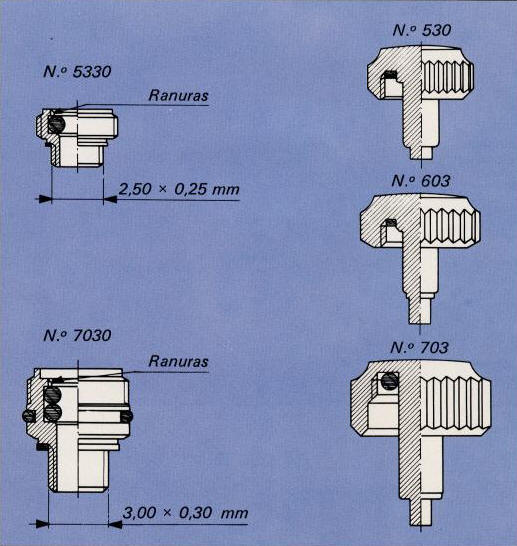

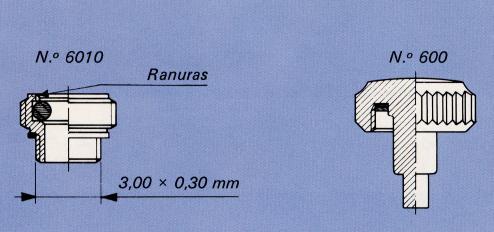
- Acero is Spanish for Steel
- Oro amarillo means Yellow Gold
- Oro blanco means White Gold
- Platino means Platinum
- Coronas means Crowns
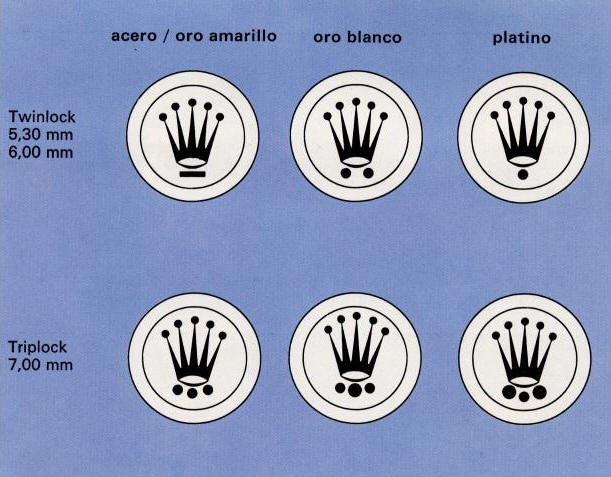
Photo source: http://www.horologist.com/rolex_crown.htm
Rolex Triplock crown
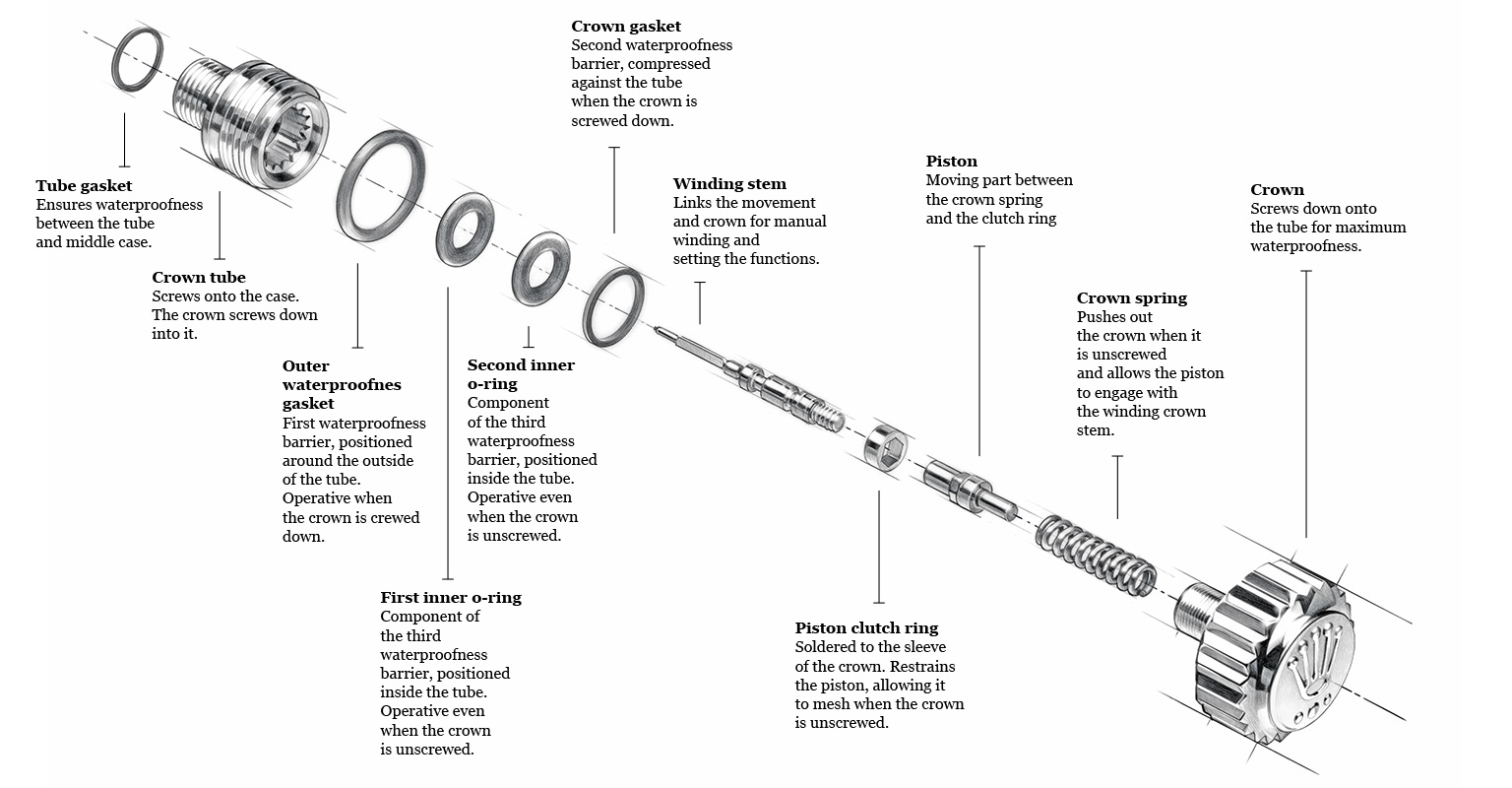
”Rolex improved the mechanism in 1953 by developing the Twinlock winding crown, with a double waterproofness system which it introduced on its first divers’ watch: the Submariner. The metal gasket at the base of the crown was replaced by two O-rings in a synthetic material.
The first, inside the crown, presses against the top of the tube, as previously, to lock the case when the crown is screwed down. The second is positioned inside the tube, around the winding stem, to offer protection even when the crown is unscrewed. It offers another advantage in that it stabilizes and provides secure support for the stem when it is moved. The Twinlock crown is fitted today on most Rolex watches and guarantees their waterproofness to a depth of 100 metres.”
Rolex Triplock crown
”The third-generation waterproof winding crown named Triplock, is fitted with a triple waterproofness system. It was introduced in 1970 to equip the Sea-Dweller, the model designed for professional deep-sea divers. To further reinforce the waterproofness, even if the crown should remain unscrewed underwater, Rolex engineers added a second O-ring inside the tube. This acts as a kind of airlock, safely keeping out even the minutest particles. The Triplock system was fitted in the Submariner starting in 1977. Today, it equips all the brand’s divers’ watches as well as a number of other Professional models.”
More Rolex crown resources:
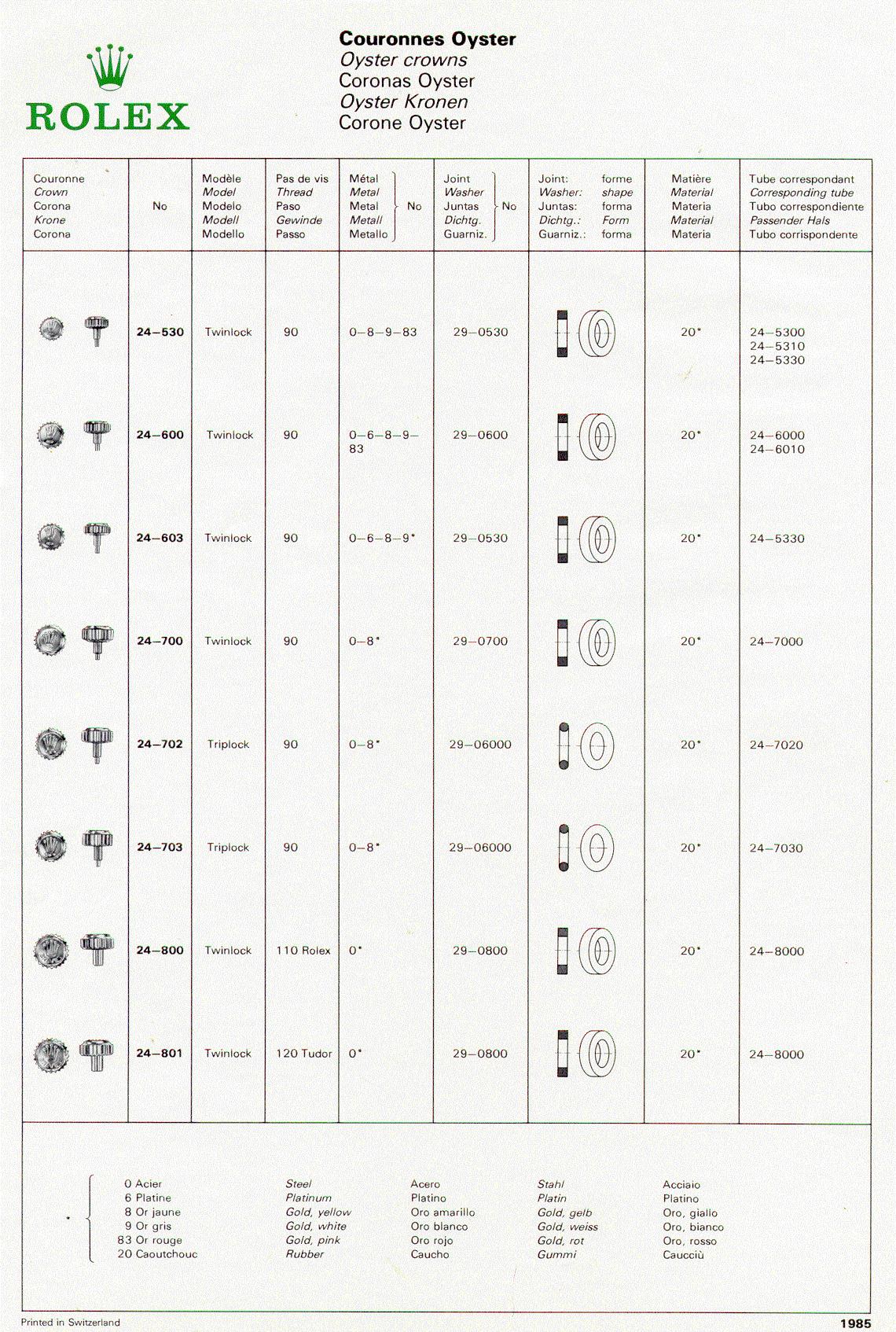
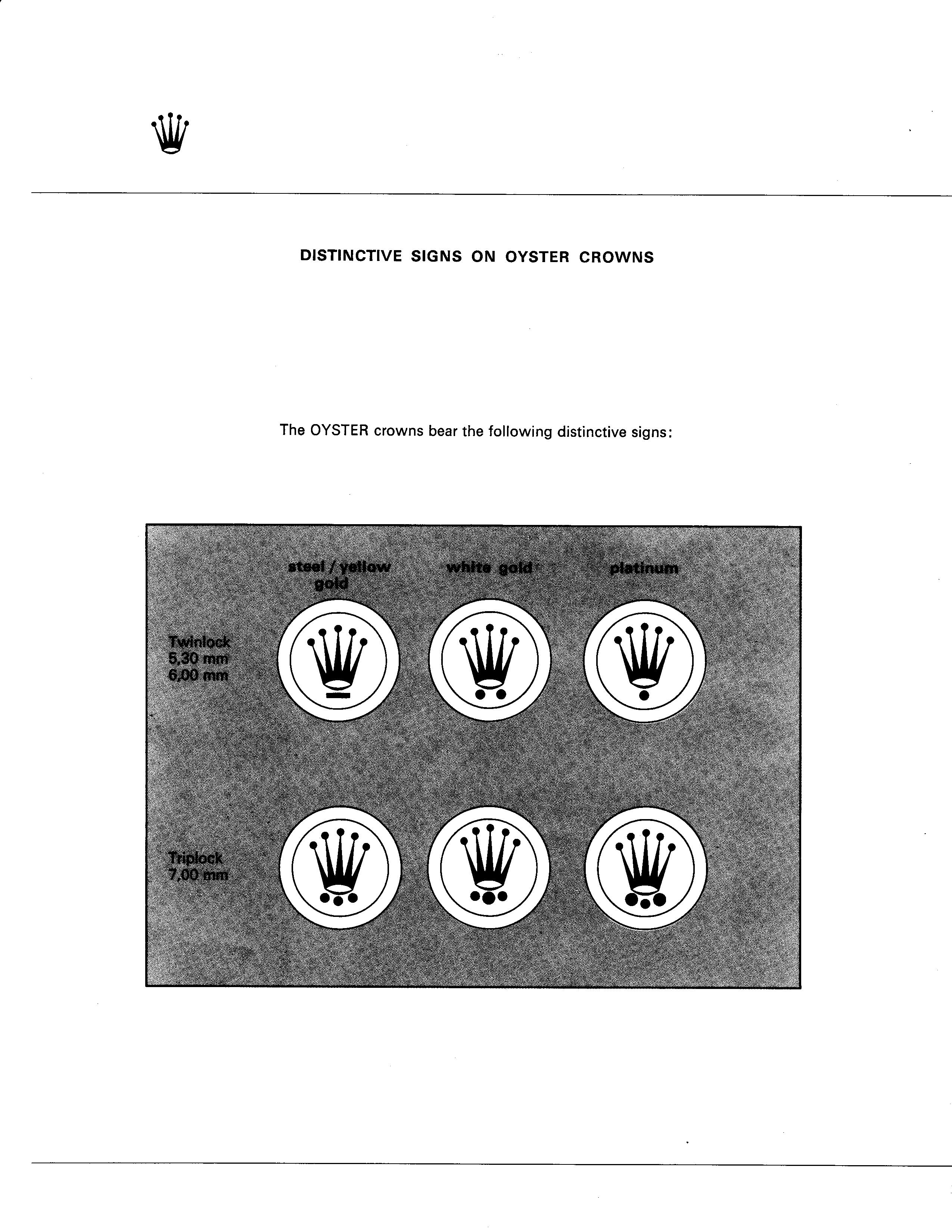





Hi
Could you tell me the difference between Rolex Crown 24-603 and 24-604
Thanks
Hi,
The crowns are used for different models. They are both used for many references and largely for the same models but some models varies, for example:
24-604 was used for 16710 but 24-603 was not. The differences are minimal.
Kind regards,
Millenary Watches